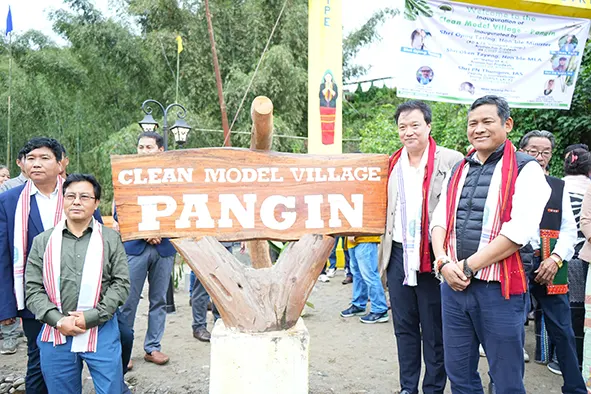PANGIN, 27 Apr: In a significant milestone for community-led development, Pangin village in Siang district was officially inaugurated as a Clean Model Village (CMV), under Siang district’s ‘Swachhta Hi Seva’ initiative, on Sunday.
The inaugural function was attended Rural Development & Panchayati Raj Minister Ojing Tasing, Mebo MLA Oken Tayeng, Deputy Commissioner PN Thungon, Skill Development and Entrepreneurship Director Sibo Passing, and others.
Pangin has become third CMV, following the successful transformations of Pagak (Kaying circle) and Lokpeng (Pangin circle).
The journey to the CMV status began in January 2025 under the leadership of Pangin Circle Officer Niyang Pertin, supported by the DC and the Pangin ADC. Understanding that true transformation could only be achieved through people’s participation, the circle officer prioritised a bottom-up strategy, ensuring that the movement remained community-owned from the outset.
An inclusive and participatory approach was adopted, starting with extensive community engagement and
consultations to understand local needs. To institutionalise the initiative, a Village Development Committee was constituted under the leadership of president Tadi Panor, comprising gram panchayat members, gaon burahs, youth groups, and women’s collectives. Following this, awareness campaigns, mobilisation drives, and voluntary donation efforts were launched to foster a sense of ownership among the villagers.
A hallmark of Pangin’s transformation was the effective convergence of multiple government schemes, carefully coordinated to maximise impact. MGNREGA funds were leveraged for critical works like the repair and dredging of the PMGSY drain; panchayat SOR funds were used for installing decorative street lamps and iron dustbin stands. The Sports Department supported the creation of an open-air gym, promoting fitness and healthy living. The Forest Department partnered in an extensive avenue plantation drive, enriching the village’s natural environment.
Meanwhile, rejuvenation efforts such as the revival of the Ruteng stream, development of an artificial lake, construction of a bamboo bridge, tree houses, scenic viewpoints with walking trails, and the painting of the welcome gate transformed Pangin into a visually striking, eco-friendly, and tourism-ready destination. Importantly, these works were not outsourced – they were built with the active participation of the villagers themselves, using locally available materials wherever possible, further cementing their sense of ownership.
Special emphasis was laid on awareness programmes about rural tourism, where AE and co-founder of Emudu Trekkers Jimu Mele sensitised the villagers to linking cleanliness efforts to local economic growth. Regular mass cleanup and plantation drives were conducted, laying the groundwork for sustainable community-led tourism. The movement was also supported by donations from various well-wishers from all over the state.
Speaking on the occasion, minister Tasing lauded the villagers’ efforts, stating, “Pangin stands today as a mirror of cleanliness and community spirit for the entire Siang district. Cleanliness is not merely a task, but a way of life.”
He called upon all heads of departments to adopt a village each. “I also urge the public to actively promote rural tourism and cultural preservation, with a weekly showcase of local folkdance and folklores to enrich the experience of visiting tourists,” he added.
MLA Tayeng highlighted the adventure tourism potential of Siang district. “With its natural rivers and highlands, Siang is ideal for rafting, angling, trekking, and high-altitude expeditions. This potential can be harnessed through proper training of our youths to become self-reliant through tourism, homestays, and guided services,” he said.
DC Thungon in his address highlighted the administration’s support and the villagers’ hard work.
Pangin village comprises Pangin Moruk and Pangin Moli, with a total household of 104 and a population of approximately 1,000. Pangin’s success is a testament to what community leadership, strategic planning, and convergence of departmental efforts can achieve.




